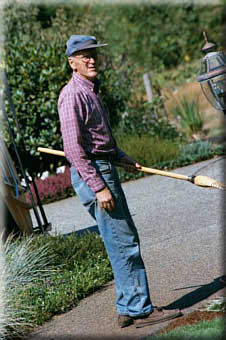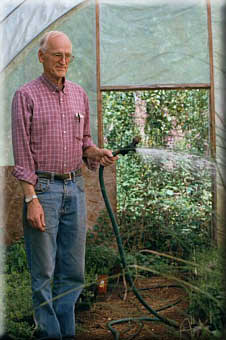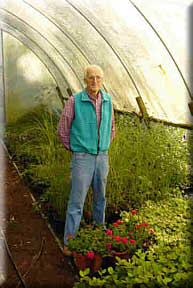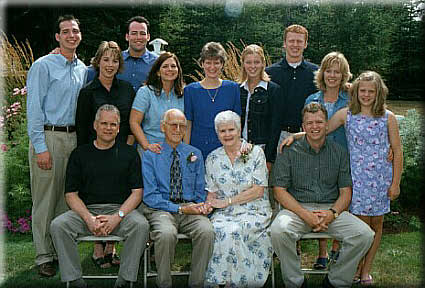Seeking Alimta and Cultivating His Garden
Pete Gustafson knelt down to show me how he prunes the big pink balls of Sedum Autumn Joy Succulents. He gently brushed aside several honey bees who were pollinating the flowers. The bees went about their business, as if they knew Pete, and, knowing Pete, they knew he meant no harm.
Several species of heather, fuscia, begonia, hydrangea, rhododendron and other flowers adorn Pete's home in upstate Washington. The 71 year-old former lather and insulator has always loved flowers. Back in the early 1950s at Washington State University, he pursued a degree in ornamental horticulture. With hungry mouths to feed and the prospects for a livelihood in the flower business dim, Pete left college after three years to work in the construction trades, but his passion for flowers never left him.
A TENDER OF FAMILY, FLOWERS, AND FAITH
Pete retired from the insulator trade in the early 1990s, primarily to care for his lovely wife Charlaine, who had been diagnosed with breast cancer. Once she recovered, Pete devoted much of his free time to growing flowers, particularly heathers. He built two greenhouses on his five-acre property, along with a massive garage which houses his motor home. In the neat and tidy greenhouses Pete has been cultivating pink, mauve, yellow and white heathers, which he intends to transplant to the new church building location, the same church he and his brothers helped build back in the mid-1960s.
Along with flowers and shrubs, Pete and Charlaine also have a vegetable garden, several fruit trees (including delicious Asian pear, cherry and apple), a vineyard of sorts with plump purple grapes (Fredonia, which are used for wine-making, but taste pretty good off the vine), and rows of berry bushes. If asked, Pete can identify every plant and provide a brief history.

Pete talked about his passion for gardening only because I asked and kept asking. When I asked him what he liked about "creating gardens", I learned why he was reticent: "I didn't create these," Pete said serenely, pointing to the beautiful flowers which he in fact planted and has cared for. "God did. Idolatry comes in many shapes -- we can become too consumed by our passions. My purpose is not to spend all my time with plants. My purpose is to serve God, and this is one way I do that."
Pete made me think of Narcissus, the young man of Greek mythology who was promised a long life as long as he never looked in the mirror upon his own features. But he did look, and was so taken with his own beauty that he fell into the water which reflected his image and drowned. Pete is the polar opposite: he focuses not on himself but outward, on glorifying God, by carefully tending His Creation, be it through gardening, his work as an insulator and lather, or being a faithful father, husband and churchgoer.
Pete and Charlaine raised three children who mirror their parents' attributes. Debra is a minister; Ken, a fire division chief; and Bruce, a successful businessman. Both Ken and Bruce were student body presidents at Bellingham High School, and now the legacy has passed to Bruce's son.
TROUBLES SUBSIDE, THEN RETURN AND MULTIPLY
Pete and Charlaine were childhood sweethearts. Just a few months ago, over 275 friends and relatives celebrated the Gustafsons' 50th wedding anniversary. Eight years ago, when Charlaine became sick with breast cancer, Pete stopped working so he could spend full-time helping his wife with her treatments.
Charlaine underwent a mastectomy in 1994. After many radiation treatments, the tumor went into remission, and she regained her usual vigor. Unfortunately, the tumors re-appeared in 2002, which forced her to undergo an extensive chemotherapy regimen. While caring for Charlaine during the recurrence of her cancer, Pete began to notice a pain in his right chest. At first, he thought the pain was the lingering after-effect of a recent chest cold. To be sure, he met with his family doctor, who ordered chest films.
The chest films showed a moderate-sized right pleural effusion, moderate pleural thickening and a right nodular mass on the lung periphery. His doctors kept asking Pete about his asbestos exposure history. Pete had been exposed to asbestos since the early 1950s as both a lather and an insulator. However, he never thought the disease would strike him, as he never smoked, exercised daily, maintained a positive outlook on life and never ate a meal without a vegetable or fruit involved.

On June 11, he underwent a CT scan at St. Joseph's Hospital in Bellingham. The CT scan revealed multiple pulmonary nodules in the chest cavity, plus a worrisome 2.5 cm mass abutting the pleura in the right lateral chest. His doctors recommended a biopsy.
On July 5, Pete underwent a CT-guided biopsy at St. Joseph's. Multiple biopsies were obtained and sent to a pathology laboratory in Seattle. Immunohistochemical evaluation revealed a diagnosis of malignant mesothelioma, epithelial cell type. Pete was shocked and dismayed -- not for himself so much as for Charlaine. She needed his help, but now they would both need help.
THE GUSTAFSON FAMILY RALLIES TO FIND TREATMENT
With his sons Ken and Bruce on point talking to doctors and researching treatment options, Pete traveled to Seattle to meet with the "big city" surgeons and oncologists. An MRI taken on August 5 revealed multiple-sized, pleural-based masses, consistent with a diffuse tumor like mesothelioma, but the pictures also showed a left-sided mass, which raised the specter of bi-lateral tumor activity. The surgeon ruled out surgery as an option because of the extent of the right-sided tumor, which he graded as Stage III, and the apparent metastasis of the cancer to the left chest cavity.
The Gustafsons sought another opinion. They learned of Dr. Eric Vallieres at the University of Washington Medical Center in Seattle, Washington. Dr. Vallieres serves on the Science Advisory Board of the Mesothelioma Applied Research Foundation, Inc. (MARF), a not-for-profit corporation whose mission is the eradication of mesothelioma as a life-ending disease. On August 19, Pete met with Dr. Vallieres, hoping for better news. Unfortunately, Dr. Vallieres' advice echoed the previous surgeon's. He ruled out surgery, because of the likely spread of the cancer to the left from the right chest and probable lymph node involvement as evidenced on CT scans and MRI.
Now what? The Gustafsons contacted Dr. Hedy Kindler at the University of Chicago about the availability of experimental treatments. The Gustafsons also researched Alimta extensively, and were impressed with Dr. Nicholas Vogelzang's pronouncement that Alimta should be considered as "the standard of care" for patients with advanced mesothelioma Dr. Vogelzang and Dr. Kindler also serve on the Science Advisory Board of MARF.

The Gustafsons learned of an Alimta/Cisplatin Phase III trial, which unfortunately had closed and was not available in the Pacific Northwest. They discovered that Eli Lilly, the manufacturer of Alimta, had helped created an "expanded access" program for obtaining Alimta on a "compassionate use" basis.
The Gustafsons urged their local oncologist in Bellingham to utilize Lilly's expanded access program to obtain the drug off-protocol. They also began to research the availability of the drug at other medical clinics who had already obtained certification. (The Food and Drug Administration must certify and approve a clinic before allowing an experimental cancer drug to be administered). The Gustafsons learned of ongoing protocols in Bend and Portland, Oregon using Alimta to treat colon cancer.
Unfortunately, as of this writing, Pete Gustafson has not yet received Alimta. The paperwork requirements have proved overwhelming for his local oncologist, who has a busy practice, a small staff, and insufficient resources available to plow through the stacks of forms that stand between his patient and the experimental drug.
Pete has made contact with an oncologist involved in the Portland Alimta protocol. This oncologist felt that Pete would be an excellent candidate, pending the results from recent CT scans, as well as blood work to rule out anemia. If this does not pan out, Pete is prepared to travel to Palm Springs where another client of this firm, Ron Simkins, who also was Stage III, was able to secure Alimta on a compassionate use basis within ten days of making the initial request.
If Pete is not eligible for Alimta, or decides in favor of a regimen that is closer to home (Portland is about 220 miles South of Ferndale), he may choose the "CMV protocol', which involves Cisplatin, Methotrexatre (a close chemical relative to Alimta, which Dr. Vallieres at the University of Washington has been using in its tri-modal protocol for several years) and Vinblastine. He is also reconsidering a trip to the University of Chicago, where Dr. Hedy Kindler has been exploring several chemotherapy options, such as the following:
- Gemzar/Cisplatin +/- anti VEGF
- Adriamycin +/- Onconase
- Anti-mesothelin antibody
- Gleevec
- A Salmedex drug
- OSI/Gemzar/cisplatin phase I, and several other drugs in phase I.
Pete has been speaking to several patients who have "blazed their own trail" so to speak, such as Al Todak.
SERENITY IN A STORM OF WOES
Meanwhile, Pete is tending to the needs of Charlaine and his church. Charlaine's cancer has appeared in her bones and spine, and she is undergoing an aggressive regimen of chemotherapy. Pete has been driving Charlaine to her appointments, and his family is standing by to help Pete get to his appointments when he is finally enrolled in his own chemotherapy program.
In his spare time, Pete continues to cultivate his garden. In the mornings, he surveys his lawn and garden for the pesky moles that seem to frolic while he sleeps. It's almost a game. In the mornings, he buries the holes. At night, the moles come out to play. Pete refuses to bomb the little creatures with poisons.

His heathers continue to flourish. He looks forward to the day when he can plant them at his new church building, the same church that he and Charlaine were married in 50 years ago, the same church which he helped build with his brothers in the mid-1960s.
Volunteer work which gave Pete such satisfaction now is tinged with some regret. Pete and his brother used asbestos-containing joint compounds and plasters on the church building, completely unaware of the risks of the work. Words cannot describe how Pete feels about being an unwitting accomplice to the mass poisoning perpetrated by the asbestos companies in this country, particularly when he considers that he recruited his own sons to work with him with asbestos products in the early 1970s.
Pete has not let anger or bitterness consume him. Even after the first drops of a rain of woes have built into a storm, Pete serenely tends to God's work, Charlaine's survival and his own, cherishing each day, true to a faith that is so ingrained that it is him. In an out-of-the-way place on the western edge of our country, in a slight, unassuming man, I did not expect to find this heroism -- part Voltaire's Candide, aware of evil howling in the outside world, persistently tending his own garden; part Job, and the answer to the question: "How should the righteous suffer?"
*** POSTED OCTOBER 21, 2002 ***
Mr. Gustafson passed away on August 16, 2004


